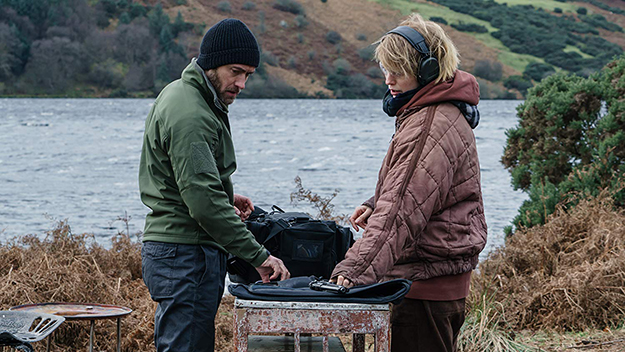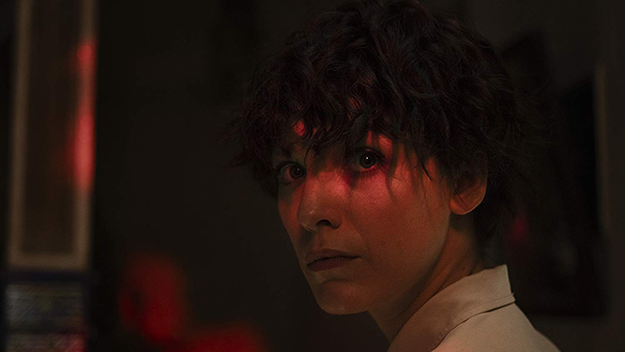Deep Focus: The Rhythm Section

Blake Lively in The Rhythm Section (Reed Morano, 2020)
The bombs total three, if you count the movie. Reed Morano’s abysmal espionage film centers on a top Oxford student who falls into drug addiction and prostitution after her family dies in a plane crash. She goes into mission mode once she learns that terrorists caused the crash. Stephanie Patrick (Blake Lively) pleads with a rogue British op known as “B” (Jude Law) to train her so she can catch and kill the bomber, who is on the loose. If B were named after this grade of picture, he would have been called “D” or “F.”
B remarks that her drug addiction and whoring comprise a “cliché” rather than a tragedy. Working from a script that novelist Mark Bunnell devised from his own book, Morano must have agreed. But she fails to transform the stock pulp heroine—a young middle-class woman who numbs her feelings with substance and other abuse, then redeems herself and saves a few pieces of the world. The director tries to disguise the shortcomings of this secret-agent origin story with a thick, impressionistic style.
We see the plot develop from Stephanie’s perspective and the action unfold from vantage points close to her face. Morano, a former cinematographer herself, and her first-class director of photography, Sean Bobbitt, give us partial, obstructed, or distorted views of each pursuit or showdown. Initially B registers as a bearish shadow, then as a pair of boots. By the time Law shoves his visage into the frame, we’re desperately glad to see him. Law’s wit and charisma almost always perk up the audience—but, alas, not here. As Captain Marvel’s martial arts tutor and would-be tough-love authority figure, Law was preternaturally crisp. As Stephanie Patrick’s, he’s burned out.

Jude Law and Blake Lively in The Rhythm Section (Reed Morano, 2020)
Morano (The Handmaid’s Tale) must believe that aggressive camerawork will put us in Stephanie’s heels. But this anti-heroine remains a cipher. Lively has been a first-class action performer in The Shallows (2016) and a droll, quicksilver friend fatale in A Simple Favor (2018). As Stephanie she overdoses on earnestness, depression and confusion; as her assassin alter ego Petra, she’s risibly panicky and brittle. POV shots go for naught in a film that has no credible point of view. The Rhythm Section induces a dreary, exhausting claustrophobia varied only by flashes of virtuosity, such as a getaway filmed entirely from Stephanie/Petra’s passenger seat, or by images that are semi-pretentious and semi-picturesque: Stephanie’s solitary figure struggling up a lonely, hilly Scottish road; her scantily-clad body withstanding hypothermia as she swims through a dark, deep loch.
This is just the third film Eon Productions has made outside the major James Bond cycle. Eon’s Barbara Broccoli co-produced the second, 2017’s Film Stars Don’t Die in Liverpool, showcasing Annette Bening’s uncanny performance as the aging Gloria Grahame. Broccoli produced The Rhythm Section with Eon partner Michael G. Wilson. Bunnell’s book kicked off a print series of Stephanie Patrick thrillers, and though Broccoli may have sought to launch a female-centered franchise with this picture, no one will be clamoring for a sequel to The Rhythm Section.
A few days ago, I picked up Bunnell’s far more straightforward and realistic novel and whipped through it to the point where Stephanie enters training. It reminded me of how refreshed I was as a boy by the grungy ambiance of Ian Fleming’s 1962 The Spy Who Loved Me and how intrigued I was by its first-person female narration. The Spy Who Loved Me, of course, with a whole new plot, became a transcendently deluxe and playful movie. The Rhythm Section has turned out artier than the artiest Bond entry: 2008’s Quantum of Solace.

This movie is devoid of thrills and personality and short on incident and local color. (In the novel, Stephanie goes to Durham University, not Oxford, and considers a college education “just a phase to be endured.”) In her collapsed eight-month commando practice regimen, Stephanie develops no discernible skills. So we lose any vestige of hope for the film when B abruptly announces that he’s sending her into the field.
The narrative disintegrates in an instant. Stephanie/Petra simply receives one set of instructions after another that lead her to appalling fat cats/bad guys attached to the airplane’s annihilation. She barely manages to execute one hit, then balks at another. She announces that she will do things “my own way,” which triggered a Wayne’s World-flashback in my head: “No way!” The movie trashes exotic places, reducing Tangiers, Marseilles, and Madrid to a succession of sunbaked roofs and seedy alleys, and it misuses talented performers, like Sterling K. Brown, who is in turn irritatingly opaque, ingratiating, and ambiguous as an ex-CIA man turned information broker.
The title derives from B’s advice to Stephanie, “Your heart is the drum, your breathing is the bass. You get those two sorted, then you’re sorted.” That may work to focus Stephanie when emotion gets the better of her. But exaggerating her pulse and ragged inhales on the soundtrack fails to quicken the audience’s breath or heartbeat. This film did nothing for my vitals. By the end I felt on my way to flatlining.
Michael Sragow is a contributing editor to Film Comment and writes its Deep Focus column. He is a member of the National Society of Film Critics and the Los Angeles Film Critics Association.







